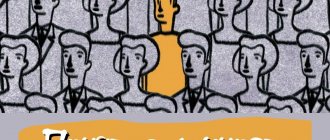If we talk about personality typology, according to “Psychoanalytic Diagnostics” by Nancy McWilliams, she identifies several leading types. In this article we will look at the paranoid personality type. The article is structured on the principle of gradually illuminating the main features of the type, its characteristics, signs, and peculiarities of how a psychologist works with it. The reader who is interested in issues of self-development, self-knowledge, and the study of psychology will find in this note information about one of the personality types.
Psychological characteristics of the paranoid personality type
The leading characteristics of the paranoid personality type are suspicion, wariness, absence or a dull sense of humor.
A paranoid person treats his qualities as negative, projecting them externally. And then they are perceived as an external threat. We can say that everything that this person worries and worries about is within herself. For example, such a person may not realize that in some of his manifestations he is quite aggressive and, projecting this quality onto other people, notes these traits in them.
Also often in paranoids one can observe a consciousness of their own greatness.
A paranoid person must suffer greatly in order to seek psychological help; they are not inclined to trust strangers. And in this regard, they tend to avoid consultations with psychologists and trust few people.
Paranoid individuals often play political roles where their projective traits may be opposed to existing views. They can “climb onto an armored car” to prove something to someone. True, it is important to note that such people do not always exaggerate the real danger. However, they can also be ironic and suspicious.
Description
Paranoid personality disorder is a pathological exacerbation of characterological traits such as suspicion, wariness, distrust, and readiness to display defensive aggression.
The synonymous name is paranoid psychopathy. The code in ICD-10 is F60.0. People with paranoid personality disorder are characterized by inflated self-esteem, excessive sensitivity to other people's opinions, to negative evaluation from others, a tendency to oppose themselves to the world, and a heightened sense of self-esteem. They are constantly looking for a threat from the outside, do not trust others, and fear attacks on their health, property and rights. The prevalence of paranoid psychopathy ranges from 2-3 to 14% depending on age, most often it is diagnosed in adolescents. Also, increased epidemiological indicators are observed among residents of large cities, among groups with low socio-economic status. Men are two times more susceptible to this disorder than women.
The pathogenesis of paranoid psychopathy is complex and multifactorial. The influence of biological and environmental factors is undeniable. Biological reasons include genetic predisposition and organic lesions of the brain, and environmental reasons include characteristics of upbringing, material and living conditions. The risk of developing paranoid personality disorder increases if the following factors are present:
- Psychological trauma in childhood. In the course of longitudinal studies, it was found that paranoid psychopathy is more often formed in adolescents and adults who experienced violence (physical, sexual, psychological) in childhood.
- Organic brain damage. The cause of psychopathy can be traumatic brain injury, stroke, drug and alcohol intoxication, or the onset of Alzheimer's disease.
- Hereditary predisposition. Sometimes paranoid psychopathy is the initial stage of schizophrenia spectrum disorders, so people with this type of personality disorder often have relatives with schizophrenia and schizoaffective disorders.
- Features of education. Paranoidity as a character trait is more often formed in people who were brought up in an atmosphere of competition with brothers and sisters, as well as those who lived with a stepfather or another person who “came” from the outside.
Drives, affects and temperament of paranoid personalities
It can be said about paranoid individuals that they are less suicidal than depressed ones. They are often unfriendly. They have a high degree of internal aggression and irritability.
It is difficult for a child to control their reactions; they may have an internal feeling that they are being persecuted.
In social interactions, paranoids may not be adaptive. Hyperexcitability is also noted. They struggle with hostile feelings and have many different fears.
Most often, paranoids experience a combination of fear and shame. This can lead to resourcefulness. Such people vigilantly monitor all interactions of other people among themselves and with them.
Narcissistic individuals may be subject to feelings of shame if the mask is somehow removed from them. Attempts are made to make such an impression on others that the devalued self will not be noticed by them. Paranoid individuals, on the contrary, use denial and projection. Shame remains completely unattainable within one's own self. Therefore, a paranoid person rushes headlong at those who are trying to shame and humiliate them. At the same time, narcissistic individuals are afraid of discovering their own inconsistency with some standards, and paranoid individuals are afraid of being judged by other people.
Paranoids can be noted to focus on the motives of other people, instead of focusing on their own “I”. They love to discuss possible motivations and consequences of other people's actions.
Paronoid individuals are vulnerable to envy. They cope with it through projection, believing that they envy them. In essence, we can say that they can project and deny those qualities of other people that they have in themselves. For example, the fact that they were betrayed.
Paranoid individuals project qualities that they may not notice or deny in themselves. For example, an office employee who is constantly late may make comments about this to other employees.
Paranoid individuals are not always aware of the guilt that is projected in the same way as shame. They believe that the psychologist, having learned about their sins, will reject them. They transform any feeling of guilt into a threat coming from outside. The fear of being exposed pushes them to recognize them earlier than others, thereby preventing evil intentions towards them.
University
→ Home → University → University in the media → 13 psychotypes of personality: from paranoid to cycloid
They say there is a scale of psychotypes. How can you find out how your own child is growing up in order to help him fight his negative traits? Zinaida K., Gomel.
The classification of accentuations was developed by the German psychiatrist Karl Leonhard in 1968. Based on his works and the research of Russian psychiatrist Pyotr Gannushkin, Soviet psychiatrist, Honored Scientist Andrei Lichko created his own personality typology.
PARANOID
Traits of this psychotype rarely appear in childhood; the guys are focused on one thing, serious, preoccupied, striving to achieve what they want at any cost.
Dominant character trait: high degree of determination. Such teenagers subordinate their lives to achieving a goal (quite large-scale), while being able to neglect the interests of others. They are ready to sacrifice well-being, give up entertainment, comfort and other joys common to children.
Attractive character traits: high energy; independence; independence; reliability in cooperation when goals coincide with the aspirations of the people with whom they work.
Repulsive traits: irritability, anger, if something or someone gets in the way of the goal; weak sensitivity to other people's grief; authoritarianism.
The “weak link” of the psychotype: they are extremely ambitious in the grand scheme of things, not in small things.
Features of communication and friendship. When making contact, they often suppress their interlocutor, are overly categorical in their judgments, and can hurt others with their words. They don’t notice their own conflict. Completely unsentimental, friendship is viewed as a continuation of a common great cause. Friends are only comrades.
Attitude to study and work. Only those subjects that are needed now or will be needed in the future are carefully studied. To do this, they can go to the library, take extra classes, buy a lot of books, and read during breaks. And everything else in school is of no value. The greatest success is achieved in individual creative work. Unsurpassed generators of big ideas and non-standard approaches to solving complex problems. EPILEPTIOID From preschool age, children predisposed to this type are thrifty with clothes and toys. They react sharply to those who try to take possession of their property; From the first school years they show increased accuracy.
Dominant character traits: love of order, desire to maintain what has already been established, conservatism; high energy (students willingly engage in physical education, run, speak loudly, organize everyone around them, and with their activity often disturb others). In extreme situations, teenagers become brave and even reckless; in everyday life they show anger, explosiveness, and pickiness.
Attractive character traits: thoroughness, accuracy, diligence, frugality (often turning into pedantry), reliability (always keep promises), punctuality (in order not to be late, they will set 2 alarm clocks and also ask their parents to wake them up), attentiveness to health.
Repulsive character traits: insensitivity to the grief of others, excessive irritability due to noticed disorder, carelessness of others, or violation of rules.
The “weak link” of the psychotype: they cannot tolerate disobedience and violently rebel against infringement of their own interests.
Features of communication and friendship. They do not make casual acquaintances; they prefer to communicate with childhood friends and schoolmates. If they consider someone a friend, then they fulfill all the obligations that friendship imposes. Betrayal, either in friendship or in love, will never be forgiven.
Attitude to study and work. They are goal-oriented, complete all homework, do not skip classes, and are usually excellent students. Growing up, they perform best in work related to maintaining order, rules and regulations adopted by someone else (for example, a financier, lawyer, teacher, military man, etc.). HYPERTIME Those belonging to this psychotype have been distinguished since childhood by their noisiness, sociability, and courage; prone to mischief. They lack a sense of distance in relationships with adults.
Dominant character traits: high spirits, extroversion, joy from communication, good health and blooming appearance.
Attractive character traits: energy, optimism, generosity, desire to help people, initiative, talkativeness, cheerfulness; the mood is almost independent of what is happening around.
Repulsive character traits: superficiality, inability to concentrate on a specific task or thought, constant desire to do something more interesting at the moment, jumping from one thing to another (such guys sign up for several clubs or sections at once, but none for longer than 1– They haven’t walked for 2 months), disorganization, familiarity, frivolity, readiness to take unrestrained risks.
The “weak link” of the psychotype: cannot tolerate a monotonous environment, monotonous work that requires painstakingness or a sharp limitation of communication; they are oppressed by loneliness and forced idleness.
Features of communication and friendship. They always act as merry fellows and jokers. Their home is a meeting place for friends and acquaintances, where anyone can come and stay as long as they like. They are always drawn to the company and strive for leadership among their peers. They can easily find themselves in an unfavorable environment and are prone to adventures. They are not capable of deep affection. They are characterized by love for their neighbor (and not for all humanity); rush to help without hesitation. In friendship they are kind and unforgiving. Having offended someone, they quickly forget about it and will be sincerely happy the next time they meet; if necessary, they will apologize for the offense caused and do something nice.
Attitude to study and work. Schoolchildren of this psychotype would achieve significant success if they were not so frivolous and could concentrate on one subject. All subjects are easy for them, but the knowledge they receive at school is superficial and often unsystematic. They are constantly late for classes and skip classes (especially those classes in which they are bored and have no opportunity to express themselves). It’s easy to catch up on lost time: for example, before a test or exam, they don’t sleep for one night and learn almost everything.
Capable of achieving success in any business. At first, everything goes well for them, achievements appear, but if routine work begins, it becomes uninteresting, the activity ceases to be new, then they are ready to quit at the first opportunity and switch to something else.
Noisy and overactive, they often create the appearance of productive activity (they willingly and eagerly get down to business, plan a lot of events, hold meetings, etc.), which helps to advance their career.1
HYSTEROID
This psychotype is visible from early childhood. A cute baby, in front of a large number of adult strangers, recites poems, sings songs, and demonstrates his talents and outfits without any embarrassment. The main thing for him is admiring spectators. If guests sat down at the table and forgot about it, it will certainly attract attention again. If unsuccessful, he will knock over a glass on the tablecloth or break a saucer.
Dominant character traits: demonstrativeness; the desire to constantly be the center of attention, sometimes at any cost; thirst for constant admiration or surprise, veneration, worship.
Attractive character traits: perseverance, initiative, sociability, dedication, resourcefulness, activity, pronounced organizational skills, independence and willingness to take leadership (although after a burst of energy, the listed qualities quickly fizzle out).
Repulsive character traits: a tendency to intrigue and demagoguery, hypocrisy, cockiness, recklessness, thoughtless risks (but only in the presence of spectators), boasting about non-existent successes, taking into account only one’s own desires, inflated self-esteem, touchiness.
The “weak link” of the psychotype: inability to withstand blows to egocentrism, exposure of fictions.
Features of communication and friendship. They constantly need numerous viewers. In principle, this is the main form of their life (in public and for people). But, as a rule, they communicate only with those who express their admiration and idolize their abilities and talent. Very often they are selective, striving to be friends with famous people in order to be in the shadow of their fame, or with those who lose to them in order to shade themselves even more.
Attitude to study and work. Often this is just a reason for communication, an opportunity to express yourself among people. They go to school for fun. To attract attention, they study not just well, but better than anyone else, surprising teachers with their abilities in various subjects. In principle, these are gifted, talented people who are easily given professions related to artistic creativity. They work best outside the team and outside the mandatory framework. SCHIZOID Since school years, such children like to play alone, are not drawn to classmates, avoid noisy fun, preferring the company of older children. In adolescence, isolation and isolation, and an inability to empathize with others are striking.
Dominant character trait: introversion. This is a pronounced mental type, constantly analyzing the surrounding reality.
Attractive character traits: seriousness, restlessness, taciturnity, stability of interests and constancy of activities. As a rule, these are talented, smart and unpretentious schoolchildren. Productive, they can work on their ideas for a long time, but do not push through them, do not implement them.
Repulsive character traits: isolation, coldness, rationality. Such children have low energy and are inactive during intensive work - both physical and intellectual. Emotionally cold. Their egoism is unconscious. At the same time, they are vulnerable, because they are proud. They do not tolerate criticism of their system.
The “weak link” of the psychotype: they cannot tolerate situations in which it is necessary to establish informal emotional contacts, and the violent invasion of strangers into their inner world.
Features of communication and friendship. Very selective; people are hardly noticed, like many things in the material world. But they still need communication that is deep and meaningful. The circle of people with whom they come into contact is limited (as a rule, they are older). They are characterized by self-sufficiency in the sphere of relationships; they can communicate with themselves or with one person. A friend is one who understands their characteristics well and does not pay attention to oddities, isolation and other negative character traits.
Attitude to study and work. They are capable and talented, but require an individual approach, since they have a special vision of the world, their own point of view on ordinary phenomena and objects, unlike others. They know how to study a lot, but not systematically, because it is difficult to fulfill generally accepted requirements, and not according to the scheme they themselves invented. When they see that a teacher evaluates the result of work, and not formal compliance with mandatory rules, they show all their talent. If the teacher and parents require children of this psychotype to solve problems in a strictly defined way (as explained in class), then they will fall behind, despite the fact that they are quite capable of solving the same problems in several original ways. This applies not only to mathematics, but also to other academic subjects. Most often, such guys make excellent scientists, for example mathematicians or theoretical physicists. PSYCHASTENOID Along with some timidity and timidity, such children have a tendency to reason and have intellectual interests that are beyond their age. From a young age they suffer from various phobias - fear of strangers, new objects, darkness, being alone at home, etc.
Dominant character traits: uncertainty and anxious suspiciousness, fear for one’s future and loved ones.
Attractive character traits: accuracy, seriousness, conscientiousness, prudence, self-criticism, even mood, loyalty to promises, reliability.
Repulsive character traits: indecisiveness, a certain formalism, a tendency to long discussions, self-examination. There may be fears regarding an unlikely future, based on the principle “no matter what happens” (hence the belief in omens). Another form of protection against constant fears is conscious formalism and pedantry, which are based on the idea that if everything is carefully thought out in advance, foreseen and then acted without deviating a single step from the planned plan, then troubles can be avoided. Such teenagers find it difficult to make decisions; they constantly doubt: have they taken everything into account? But if they dare, they begin to act immediately, because they are afraid that they will change their mind.
The “weak link” of the psychotype: fear of responsibility.
Features of communication and friendship. They are shy, self-conscious, and do not like to make new contacts. They have few friends, but this friendship lasts forever. They remember the smallest details of the relationship and are sincerely grateful for your attention.
Attitude to study and work. They are able to study without raising their heads, showing determination, perseverance and perseverance for a long time, because they are afraid of upsetting their loved ones and teachers with low grades. The result obtained is checked against reference books, dictionaries, and encyclopedias; They'll call a friend and ask him.
These are ideal subordinates: they will complete any work carefully, accurately and on time, if the task is specific and there are instructions clearly regulating the procedure for its implementation. Such people like a quiet profession, for example, a librarian, accountant, or laboratory assistant. SENSITIVE From the first steps, these guys are fearful, afraid of loneliness, darkness, animals, especially dogs. They avoid active and noisy peers, but are sociable with those they are accustomed to; They love to play with kids: they feel confident and calm. They are very attached to their family and friends, these are “home children”: they try not to leave their native walls, they do not like to visit, much less travel somewhere far away (for example, to another city, even if their beloved grandmother lives there).
Dominant character traits: increased sensitivity, impressionability. Children are timid and shy, especially among strangers and in unusual surroundings. They see many shortcomings in themselves.
Attractive character traits: kindness, calmness, attentiveness to people, a sense of duty, high internal discipline, responsibility, conscientiousness, self-criticism, increased demands on oneself. They strive to overcome their weaknesses.
Repulsive character traits: suspiciousness, fearfulness, isolation, a tendency to self-flagellation and self-humiliation, confusion in difficult situations, increased sensitivity and conflict on this basis.
The “weak link” of the psychotype: they cannot tolerate ridicule or suspicion from others of unseemly actions or unkind attitudes.
Features of communication and friendship. They contact with a narrow circle of people who arouse their sympathy. They avoid meeting and communicating with the lively and restless in every possible way. They prefer to share experiences and sensations with old friends.
Attitude to study and work. They study because they do not want to upset their relatives and teachers. They are embarrassed to answer at the board, they are afraid that they will be called an upstart. With a friendly attitude from teachers, they show excellent results. For them, work is something secondary; the main thing is warm and kind relationships with colleagues and the support of their manager. They can be executive and devoted secretaries, assistants, etc. HYPOTHYMOUS They do not show much joy, they are offended by everyone, especially by their parents. There is an expression of dissatisfaction on their faces, frustration because they did not do it the way they wanted.
Dominant character trait: always in a minor key.
Attractive character traits: conscientiousness, keen critical view of the world. They strive to be at home more often, to create comfort and warmth, thereby avoiding unnecessary worries.
Repulsive character traits: touchiness, vulnerability, despondency, tendency to look for illness in oneself, almost no interests and hobbies. Fast fatiguability.
The “weak link” of the psychotype: open disagreement with a different perception of reality.
Features of communication and friendship. Often and for a long time they are offended by others and friends, although they urgently need communication, so that they have someone to complain about life, about the fact that they were not understood or appreciated. I like to talk about the difficult circumstances in which I found myself. The advice of your interlocutor will be answered with a lot of arguments why nothing can be changed and it will only get worse.
It is difficult to be friends with such children: they see in any person a possible reason for the deterioration of their mood.
Attitude to study and work. They prove themselves by memorizing the material well and carefully completing assignments, but they are not particularly interested in the depth and content itself. They study for fear of a bad grade. Citing illness, they may skip classes, most often in physical education, labor training and other subjects, the teachers of which do not make allowances for a bad mood.
It happens that they complain about people, circumstances, and ask to be given another task. But everything repeats itself: shortcomings, negative aspects in the organization of production or traits in others - a whole uprising in the soul. It's hard to do one thing all the time.
CONFORMAL TYPE
This type is quite common. Children agree with everything that their immediate environment suggests, but as soon as they come under the influence of another group, they change their attitude towards the same things to the opposite. They lose their personal attitude towards the world - judgments and assessments will coincide with the opinions of those with whom they communicate at the moment. Moreover, they do not stand out, do not impose their opinions, representing the masses who agree with the leader.
Dominant character traits: excessive adaptability to the environment, almost complete dependence on family and company. Life flows under the motto: “Think like everyone else, do like everyone else, and so that everything is like everyone else.” This extends to clothing style, behavior, and views on important issues. These teenagers become attached to their peer group and unconditionally accept its value system without criticism.
Attractive character traits: friendliness, diligence, discipline, flexibility. They will not be a source of conflict or discord. They listen to the guys’ stories about “exploits”, agree with proposals from leaders, willingly participate in “adventures”, but then they can repent. They lack their own courage and determination. If the micro-team seems significant and has a positive orientation, then together with it they can achieve serious success, for example, by studying in some section.
Repulsive character traits: lack of independence, almost complete lack of criticism towards oneself and the immediate environment.
The “weak link” of the psychotype: they cannot tolerate drastic changes or breaking the life stereotype.
Features of communication and friendship. They easily establish contacts with people and at the same time imitate leaders. Friendly relationships are fickle and depend on the current situation. They do not strive to excel among friends and do not show interest in making new acquaintances.
Attitude to study and work. If everyone around them studies well, then they will make an effort to keep up with their friends. The attitude towards work also depends on the mood of the team; are able to demonstrate diligence, diligence, creativity and ingenuity, and carry out everything that is assigned. Or they may shirk or do work formally if there are slackers nearby.
UNSTABLE TYPE Since childhood, they are disobedient, restless, climb everywhere, but at the same time they are afraid of punishment and easily obey their peers.
Dominant character traits: complete inconstancy of manifestations, dependence on any person who is nearby at that moment. Easily influenced.
Attractive character traits: sociability, openness, helpfulness, goodwill, speed of switching in business and communication. Often, outwardly, such teenagers are obedient, ready to fulfill the requests of adults, but their desires quickly disappear; very soon they forget about their word or are lazy, they come up with a lot of reasons why they cannot do what they promised.
Repulsive character traits: craving for empty pastime and entertainment, talkativeness, agreement, irresponsibility.
The “weak link” of the psychotype: neglect, lack of control.
Features of communication and friendship. Non-conflicting. Their contacts are pointless. They can be part of several groups at once, adopting the rules and style of behavior of each team. Tend to live for today; They sit for hours in front of the TV, listening to music. They act as assistants to leaders.
Attitude to study and work. Under the influence of another hobby, they may begin to study well or abandon their studies, which will inevitably lead to large gaps in knowledge. Further studies become more difficult. Their knowledge is unsystematic, their attention is unstable, and during lessons they are often distracted from work for a long time. Homework is done reluctantly. Such people do not make good specialists. ASTHENIC Since childhood, poor sleep, poor appetite, often capricious, afraid of everything. Sensitive to loud sounds, bright light; they quickly tire of even a small number of people; strive for solitude.
Dominant character traits: increased fatigue, irritability.
Attractive character traits: neatness, discipline, modesty, complaisance, diligence, friendliness, forgivingness.
Repulsive character traits: capriciousness, self-doubt, lethargy, forgetfulness. Such teenagers are timid, shy, have low self-esteem, and cannot stand up for themselves. They experience great anxiety when external circumstances change and stereotypes are broken, because their psychological defense mechanism is getting used to things and their way of life.
The “weak link” of the psychotype: sudden affective outbursts due to severe fatigue and irritability.
Features of communication and friendship. They do not strive for close relationships due to uncertainty and do not show initiative. The circle of friends is limited.
Attitude to study and work. Low self-esteem often gets in the way. Constant doubts, feelings of anxiety and fear of making a mistake prevent you from working normally in class or answering at the board, even when the material has been learned. Work is tiring and does not bring joy or relief. Heavy and tense causes irritation. They need periodic rest or alternation of different types of activities.
LABILE TYPE They often catch colds. They are capable of getting upset because of an unflattering word, an unfriendly look, or a broken toy. Pleasant words, a new suit or book, good news quickly lift your spirits and give a cheerful tone to the conversation, but at any moment another “trouble” can change everything.
Dominant character trait: extreme mood swings from insignificant reasons. The state of mind determines everything: appetite, sleep, general well-being, desire to communicate, learn, performance.
Attractive character traits: good nature, sensitivity, affection, sincerity, responsiveness (during periods of high spirits). Loyalty to those with whom you are on good terms, who are loved and cared for. Moreover, this attachment remains, even if the mood has changed.
Repulsive character traits: irritability, short temper, pugnacity, weakened self-control. During a normal conversation, they can flare up and say something impudent and offensive.
The “weak link” of the psychotype: emotional rejection of significant people, loss of loved ones or separation from those to whom they are attached.
Features of communication and friendship. It all depends on my mood. If you are happy and satisfied with life, then you establish contacts with great desire; if you are upset and not satisfied, then they are minimal. They have developed intuition and easily determine a “good” and a “bad” person when choosing a friend. They prefer to be friends with those who, during periods of low mood, know how to distract, console, tell something interesting, protect in the face of attacks from others, and, in moments of emotional upsurge, share wild joy and fun. Capable of loyal friendship.
Attitude to study and work. Characterized by extreme variability; They react unpredictably to remarks and requests from the teacher or parents: in response to a remark they are able to laugh and joyfully begin to correct the mistake, but tears, irritation, and reluctance to obey the legitimate demands of the teacher are quite possible. Knowledge is superficial and unsystematic, because such teenagers do not manage themselves and cannot be controlled by adults. They switch gears, forget about their bad mood, if the work interests them, doesn’t get boring, and captivates them. CYCLOID These schoolchildren are no different from their peers, but from time to time they are unusually noisy, mischievous, and are constantly doing something. Then they become calm and controlled again. Adolescents experience periodic phases of mood swings, the duration of which ranges from several days to a week or more.
Dominant character trait: cyclical changes in the emotional background (high mood disappears, emotional decline puzzles everyone).
Attractive character traits: initiative, cheerfulness, sociability, when your soul is good.
Repulsive character traits: inconsistency, imbalance, indifference, outbursts of irritability, excessive touchiness and pickiness towards others. If you are overcome by sadness, then everything falls out of your hands; What was easy yesterday requires incredible effort today. During a recession, it is more difficult to live, study, and communicate. Companies are annoying, risk, adventure, entertainment are losing their appeal. They become “homebodies” for a while.
Mistakes and minor troubles are very difficult to experience on pessimistic days. Just yesterday they won the tournament, but today the game isn’t going well, the coach is unhappy... It’s depressing, they don’t recognize their body, they don’t understand their irritation, they don’t want to see their loved ones. They respond to remarks and remarks with dissatisfaction, although deep down they are very worried about these sudden changes. There is no feeling of hopelessness; they are confident that after some time everything will be fine again. You just need to survive the recession period.
The “weak link” of the psychotype: emotional rejection by significant people, a radical break in life stereotypes.
Features of communication and friendship. Relationships with people are cyclical: the craving for communication, new acquaintances, reckless prowess are replaced by isolation, reluctance to talk even with parents and close friends (“I’m so tired of you all”). They are truly friends with those who understand this inevitability of change in relationships and are not offended and forgive outbursts of irritability and resentment.
Attitude to study and work. Periods of active work in the classroom and at home are followed by stages when complete indifference to anything sets in. In work, everything works out and works out as long as it’s interesting; as soon as the mood drops, they are dissatisfied with everything that is offered to them.
Based on the degree of severity, we can distinguish 2 types of character accentuations, which is necessary to know for an individual approach in raising a child, when choosing career guidance, forms of personal and family psychotherapy: • obvious accentuation - an extreme variant of the norm. Character traits are expressed throughout life; • hidden accentuation is a common variant of the norm. Some special character traits appear mainly during psychotrauma.+
These 2 types can transform into each other, which is influenced by family upbringing, social environment, professional activity, and physical health. In contrast to “pure” types, mixed forms of character accentuation are much more common. Natalya Grigorieva, Associate Professor of the Department of Psychiatry and Medical Psychology of BSMU, Candidate of Medical Sciences. Sciences Medical Bulletin , July 31, 2014
Share
Defense and adaptation processes in paranoia
The degree of projection in paranoids can be borderline or neurotic.
In a disturbed personality, the Ego is completely projected and external, no matter how much these projections may appear to other people.
Individuals with a preserved “I” still have the opportunity to test reality.
Borderlines act in ways that make their projections suitable for the target of the projection. For example, a woman who does not admit her hatred and envy may tell her psychologist that he is jealous of her. And she interprets the psychologist’s empathic manifestations as a desire to control.
In neurotic paranoids, their feelings are projected in a way potentially alien to the ego. Such a person projects, but at the same time a part of his own “I” remains, which, when forming a trusting working alliance between the client and the psychologist, can reach the level of awareness.
Paranoid individuals project their feelings externally, including in order not to recognize unbalancing relationships.
Psychologist Karen, exploring paranoid dynamics, summarized the basic psychological defense mechanisms of the individual. For example, how can a person with delusions cope with the desire for intimacy with a person of the same sex. At the same time, the person seeks to refute “I love him!” through a number of ways:
- Megalomania: “I don’t love him, I love myself!”
- Erotomania: “I don’t love him, I love her!”
- Delusional jealousy: “I don’t love him, she loves him!”
- Projection of homosexuality: “I don’t love him, he loves me!”
- Reactive formation: “I don’t like him, I hate him!”
- What allows me to hate him: “He hates me! If I hate him, I don’t love him!”
Paranoia: its signs
During the course of the disease, it is difficult to identify any clear stages. Sometimes the manifestation of the disease may be preceded by a prodromal period, which is characterized by mood changes. The patient is less and less likely to be in a complacent mood. Suspiciousness, gloominess, self-absorption, pickiness are typical. A person can avoid communication, provoke scandals and conflicts.
With paranoia, symptoms usually appear when what is happening is somehow related to formed delusional ideas. Otherwise, the patient does not give the impression of a mentally unhealthy person, especially during the period of remission. He takes care of his appearance, is neat, is able to maintain a logically coherent conversation, and in some cases his ability to work is preserved.
Interpersonal relationships with paranoia
A child who grows up paranoid suffers from feelings of his own reality. He was subjected to periodic suppression and humiliation. The family can convey to the child that they are the only ones who can be trusted. This creates suspicion in the child towards other people.
Borderline or neurotic paranoid individuals come from a family system where criticism and ridicule predominate. The child may be a scapegoat.
Uncontrollable anxiety can trigger the development of paranoia in children. When a child came to such a parent with a problem, he either presented this situation as catastrophic, since he could not bear the child’s anxiety, or devalued it, since he could not condense it. Such an adult conveyed to the child that thoughts are equivalent to actions. And the child perceived that his personal feelings had dangerous power.
As children, paranoid individuals did not have the opportunity to express their feelings naturally and safely. In a psychologist’s office with such clients, a specialist teaches paranoid individuals to do this.
We can also say that paranoid individuals are capable of deep attachment and relationships.
Treatment in Re-Alt
Treatment of paranoid personality disorder is carried out comprehensively - psychotherapeutic methods are combined with drug therapy. The main condition for achieving successful results is establishing a trusting relationship with the patient, which is the main difficulty when working with such people. Due to their position in life, with elements of negativism, patients are reluctant to interact with a psychotherapist. The psychoanalytic approach is the most effective in correcting paranoid disorders. Therapy is long-term, much depends on the person's participation in the treatment process and the severity of the disorder.
Treatment of paranoid personality disorder in psychiatry is often carried out using psychoanalytic and cognitive behavioral therapy. A psychotherapist helps a person accept his feelings and develop more effective behavior patterns. For the specialist, the main task is to help the patient understand how to cope with the conflict caused by it, through reassessment and awareness.
Patients' reliance on denial directly affects the speed of treatment. This defense mechanism works by categorically refusing to acknowledge something specific. Direct interpretations of transference face even more denial. It takes a long time and support for a person to begin to accept the possibility that the shortcomings of others that he sees are in himself. A sign of successful treatment will be the person’s awareness that his negative thoughts and suspicions have no objective justification. With long-term therapy, it is possible to compensate for the severity of paranoid thinking, which increases with old age.
Drug treatment is prescribed, most often, during periods of deterioration of the condition and in short courses, due to the fact that a person may not take medications or consider them to be ineffective.
Paranoid Self
The paranoid client despises his own humiliated personality. He has a high degree of fear, which leads to the fact that he constantly “monitors those around him,” observes their reactions, “keeps his finger on the pulse.” Paranoids believe that they are the target of everyone around them, that people think and talk only about them.
It is also important to note that paranoids have a high sense of guilt.
Statistically, a connection has been found between thoughts about homosexuality and paranoid personalities, this has been confirmed by some studies.
Paranoids can fight against existing authorities. Revenge and triumph provide a temporary and shallow sense of security and moral clarity.
Transference and countertransference with paranoid individuals
Transference in paranoid clients is rapid and intense. The psychologist is the recipient of the projection of the image of the rescuer. But more often the psychologist is seen as an unsupportive, humiliating type. Such clients believe that the psychologist is trying to save them or, conversely, is focused on causing suffering. They evaluate a psychological assessment, believing that the psychologist wants to feel his own superiority.
Paranoid individuals may look closely at a psychologist. This can create a feeling of vulnerability and total protection. Transference here can be hostile and less often benevolent.
Countertransference may look like an opportunity to directly point out to the client that what the person perceives as a danger is unrealistic.
Paranoia: what to do, principles of treatment
Hospitalization is indicated in the acute period, when the patient is completely inadequate and can attack both relatives or acquaintances and completely strangers. In some cases, at the peak of delusional thoughts, the patient may try to commit suicide.
Treatment of paranoia in a hospital provides not only constant monitoring of the patient’s condition and intentions. When the syndrome worsens, it is very important to establish contact with a doctor, and often in such a situation the patient quite logically “integrates” taking medications into the structure and content of the delusional disorder.
For treatment, drugs from the group of antipsychotics are usually prescribed, and after remission is achieved, maintenance therapy with antidepressants, lithium-based drugs, and sedatives is possible.
Paranoia: how to get rid of the disease using non-drug methods
In addition to mandatory medication, psychotherapy is indicated. Group classes are ineffective and can lead to the opposite result - refusal of treatment. Therefore, at the Cordia Clinic we offer individual consultations. In a personal conversation, the doctor can determine how to treat paranoia and how appropriate it is to use potent drugs.
Physiotherapy is useful in helping to normalize sleep, reduce psychomotor agitation, and eliminate hyperreactivity of the nervous system. Sports activities have an excellent effect.
But doctors categorically warn against treating paranoia at home. Complications and worsening of the disorder can only be avoided with inpatient or outpatient therapy under the supervision of an experienced specialist. And the appearance of the first symptoms of the disease requires mandatory consultation with a doctor.
We do not give a 100% guarantee that we will be able to completely cure paranoia: some forms of the disease simply cannot be treated. But our doctors will select the appropriate medications and the right tactics of psychotherapy, which will allow you to achieve stable remission in the shortest possible time, when only maintenance treatment is required. Call us at +7 (495) 367-23-13 and sign up for a consultation!
Therapeutic recommendations when diagnosing paranoia
The first requirement is the establishment of a stable working alliance with the psychologist. This is necessary to build trust, which will make it possible to build effective interaction.
If the paranoid client trusts the psychologist, then the work can be considered completed.
The main task for the specialist will be to increase the paranoid person’s access to the client’s inner world.
Jokes within reason can safely defuse aggression. They may relate to those topics within which the work is being carried out at a given time. For example, to a client who is overly worried about how he will look on a date, you can say something like this: “If you think that you will be examined under a microscope, take blood and urine tests, then rest assured that your your partner is also worried.” This, of course, is only possible after basic trust has been built in a psychological session.
If paranoids feel that their opinions are valued, they will become more open. You can find a way to demonstrate this to them. In addition, it is important to give the opportunity to talk.
Together with a psychologist, explore what led to such reactions. This stimulates separation, which will eliminate carryover.
It is important to teach paranoid clients to identify what triggers their paranoia. Starting from observing your own body and reactions to external factors that can trigger alarming symptoms.
It is also very important with paranoids to consider other reasons besides those used by paranoid individuals. Give me the opportunity to think about it for myself. There are clients who want ready-made, and even better, quick solutions to their problems. But at the same time, they do not always understand that instead of getting a fishing rod and then independently solving pressing problems that will arise in their lives, they want to immediately get a fish.
Emphasize the differences between thoughts and actions. “Just enjoy your fantasies!” Thinking about something does not mean doing it.
A psychologist should be very careful about boundaries. This may affect the paranoid's feelings of security. May cause anxiety. Something can be done with psychological boundaries if it is possible to identify them. And their identification is realistic only after identifying oneself.
Causes of paranoia
The etiology of the disease has not yet been fully elucidated. Unlike schizophrenia and some other mental illnesses, the connection between paranoia and genetic characteristics has not been confirmed. Experts suggest that the development of pathology may be due to:
- injuries, tumors, brain surgeries affecting the limbic system and basal ganglia;
- the influence of stressful life situations and circumstances;
- specific, hostile relationships in the family;
- social isolation, lack of communication, etc.
It is believed that the development of paranoia is predisposed by severe stress, accompanied by cruel (both morally and physically) attitude of others, strong envy, anger, which is why a person is left alone. He withdraws into himself, trying to find the reasons for what happened. Gradually, anxiety and restlessness develop, and a feeling of complete hopelessness appears. In such a situation, the formation of delusional, paranoid ideas is one of the mechanisms of subconscious psychological defense.
Differential diagnosis
Paranoid versus psychopathic client: If a paranoid person notes that you share their values with them, then they are capable of loyalty and generosity. Projection is a psychological defense mechanism in psychopathic and paranoid individuals. However, the former are not empathic, and paranoid individuals are deeply connected to the object (for example, another person). The experience of betrayal can be a threat. They perceive any violations of morality in their partner as a vice in themselves that should be eradicated.
Paranoid personalities in comparison with absessive ones: the latter are sensitive to little things, they are afraid of control, but do not experience the fear of physical harm, moral humiliation, which is typical of paranoid personalities. Absessive clients try to cooperate with the psychologist, although they may have alternative positions. A violent reaction to clarification at work may indicate that the client has dominant paranoid qualities.
Paranoid versus dissociative personality: Paranoid traits may be present in dissocial personalities.
Next, let's look at the depressive personality type.
Sources
- A. B. Smulevich. Borderline mental disorders // Guide to psychiatry / ed. Tiganova A.S. - M.: Medicine. 1999.
- Katernaya Yulia Evgenievna Paranoid, schizoid and hysterical personality disorders among adolescents who have not previously sought psychiatric help // Medical almanac. 2015. No. 4 (39).
- Gorinov Viktor Vasilievich Personality disorders in adulthood and old age: on the issue of the outcome of personality pathology (analytical review) // Russian Psychiatric Journal. 2009. No. 5.
- Volodin B.Yu., Sochivko D.V., Yakovlev V.V., Frolov A.I. Current state of the problem of personality disorders // Personality in a changing world: health, adaptation, development. 2021. No. 2.
- A. Skodol. Paranoid personality disorder. 2021.











